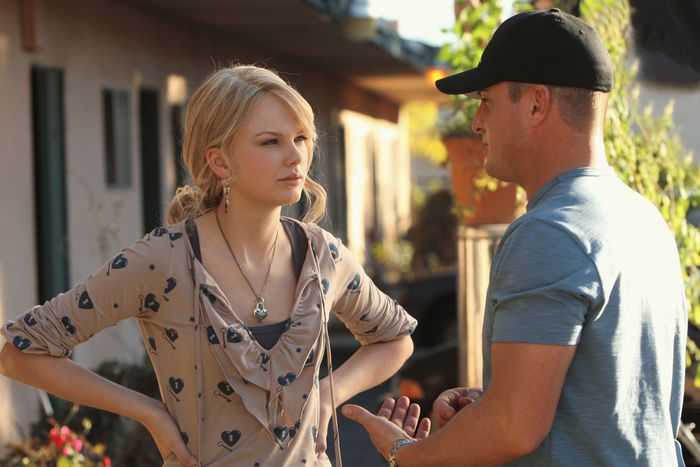
By March of 2009, you might have seen 19-year-old Taylor Swift on the cover of Rolling Stone, clutching a guitar and defiantly gazing at the camera through a puff of blonde hair. You might have seen her as the musical guest on Saturday Night Live, singing two songs from her newly released album Fearless, or celebrating the release of that album in a special on Ellen. You might have heard that she was one of the fastest-rising stars in history, and you might have already bought tickets to her upcoming 52-city North American tour, which was to kick off in April. And maybe you were flipping through channels on Thursday, March 5, when you paused on CBS to watch the new episode of CSI and saw Taylor Swift playing a dead body.
In the second scene of the 16th episode of season nine, ÔÇ£Turn, Turn, Turn,ÔÇØ there she is, sprawled on the ground in a rain-soaked motel parking lot. She looks 2000s emo, in a black wig with a white stripe in it, a sparkly stud in her nose. Las Vegas Police Department crime-scene investigator Nick Stokes (George Eads), who has left his own birthday party to rush to the crime scene, kneels over her. ÔÇ£I knew her,ÔÇØ he murmurs. He closes his eyes and the flashback starts.
Suddenly, itÔÇÖs 365 days earlier ÔÇö┬áanother birthday, another crime scene, same motel. ThereÔÇÖs a dead man in a room, and as Nick starts his investigation, heÔÇÖs met by the perky teen daughter of the motel owners. ItÔÇÖs Swift, only this time, sheÔÇÖs wearing an auburn wig and plaid oxford. Her characterÔÇÖs name is Haley, and she wants Nick to tell her all the weird murder stuff he finds. SheÔÇÖs ÔÇ£not scared of that stuffÔÇØ since ÔÇ£forensics is just science, you know?ÔÇØ
Swift herself was also not scared of that stuff. Although her guest spot did have a promotional tie-in (her Fearless song ÔÇ£YouÔÇÖre Not SorryÔÇØ plays in a moody remix when Haley looks dejectedly at a Polaroid later in the episode), it seems the whole enterprise happened simply because Swift really loved CSI. She told MTV, ÔÇ£All my friends know that my dream is to die on CSI. IÔÇÖve always wanted to be one of the characters on there that theyÔÇÖre trying to figure out what happened to.ÔÇØ
But the appearance also did quite a bit to boost the image she had begun to cultivate at the time, one which confidently asserted that big teenage emotions were valid and important, that it was okay for teens not to know who they truly were, and that they deserved to be taken seriously by adults. It also marks one of the first instances in her long-standing pattern of depicting experimentation and reinvention as essential components of self-discovery.
Haley, the daughter of crazed motel owners who despise her, is trying to find her voice when sheÔÇÖs killed. As Nick learns through numerous visits (there are a lot of crimes at that motel), HaleyÔÇÖs parents adopted her from the woman who killed their own biological daughter years ago. Because her parents clearly wish she were someone else and because sheÔÇÖs bullied at school, Haley spends the whole episode trying to figure out who she is┬áÔÇö┬áliterally. She tries on three new personalities; from a brown-haired science dork she becomes a blonde wannabe-popular girl, to a black-haired and face-pierced goth, to a depressed-looking emo, the last outfit emulating the appearance of her recently excarcerated and lately murdered birth mother. By this point, Haley is dating her teenage stalker and sometimes selling meth with him. Then, sheÔÇÖs fatally stabbed in the motel parking lot by her adoptive mother. So it goes.
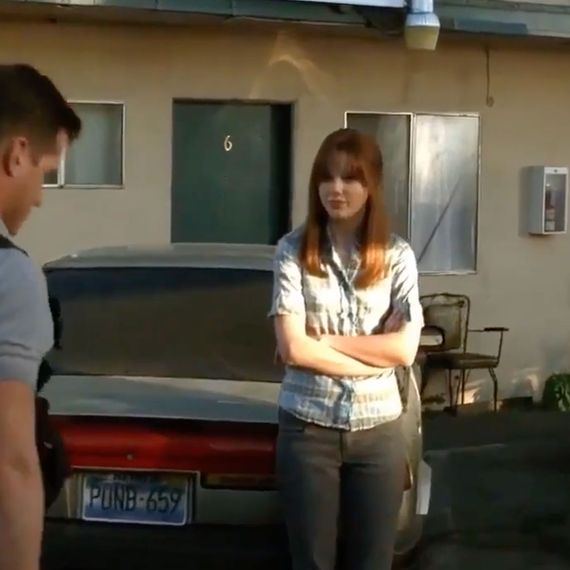
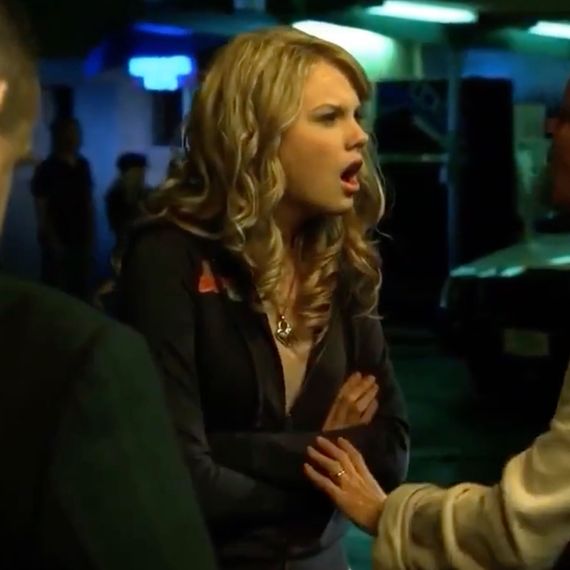
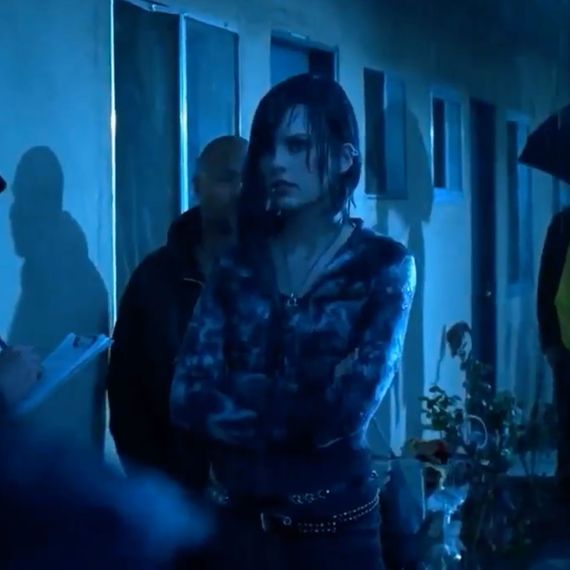
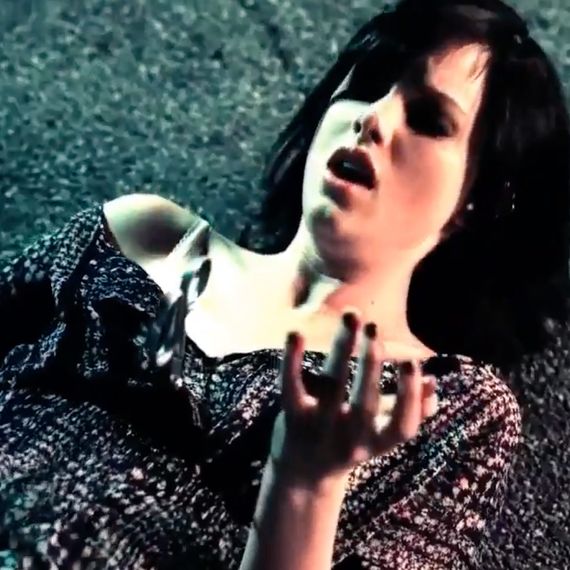
I was 16 when the CSI episode aired, and I remember how surreal it was to see Taylor Swift┬áÔÇö┬áwho had, in the short time sheÔÇÖd been a household name, consistently presented herself as knowing exactly who she was and what she could do ÔÇö playing a character so vulnerable yet lacking an outlet to reclaim this vulnerability. Through her music and public life, Swift asserted resilience amid heartbreak and betrayal. Moreover, she insisted that dwelling on those sad feelings would lead to greater strength and self-knowledge. But as soon as Haley, who had previously been drowning in her own feelings, finds a look that both helps her process that sadness and makes her feel most true to herself (the emo look that makes her look like her birth mother), it drives her adoptive mother into a frenzy. Haley is cut down in her prime precisely because she is going through what Swift insists is a natural part of being a teenager.
While the episode goes to bizarre lengths to render the tragedy of Haley Jones, it follows that Swift would have found her story profound. This is the same person who, as an 18-year-old singing ÔÇ£FifteenÔÇØ on Fearless, assured teenagers, ÔÇ£in your life, youÔÇÖll do things greater than dating the boy on the football team.ÔÇØ In an album almost exclusively about crushes on boys, breakups with those boys, and a smattering of other quotidian adolescent dramas, Swift presented herself as a slightly older and wiser girl whoÔÇÖd benefited from years of feeling her feelings, then turning them into art. High school, teenagehood ÔÇö in SwiftÔÇÖs music, these are periods where itÔÇÖs not only appropriate but virtually mandatory to feel a little bit lost, to experiment, to dream, to fight. In her music, Taylor presented herself as someone who understood, someone who went through it all and who made it to greatness not in spite of those struggles but because of them.
Reviewers of the CSI episode noted that, as the shape-shifting Haley, Swift was toying with both the ÔÇ£good girlÔÇØ and ÔÇ£angry exÔÇØ personas, ones sheÔÇÖd come to be associated with through her music. In hindsight, itÔÇÖs clear how her appearance as Haley was part of an early interest in the malleability of her public persona, which she had framed as adaptive from the get-go: On her self-titled debut album and Fearless, she is both of these Taylors,┬áand this doubleness is made literal in the ÔÇ£You Belong With MeÔÇØ music video, which premiered two months after the CSI episode aired. In it, she dons a wig to switch from the sweet blonde protagonist to the bad, about-to-be-dumped brunette girlfriend of the football player she likes.
As Haley does four times in the episode, Swift produced new variations on her image with each successive album. She may have instructed her listeners that greater things awaited beyond high school, but she did not claim that self-discovery ended after graduation, nor that it would become a less complicated process in the face of mounting fame. Some of SwiftÔÇÖs image updates were to keep time with various popular music and fashion trends (like flat-ironing that hair), but also to challenge or control the narratives swirling around her public interactions and motivations. By the time Swift made her Reputation album (to respond to speculation about escalating feuds with various artists as well as negative responses to her erstwhile brand) and abruptly pivoted to presenting herself as a femme fatale, she also reflexively acknowledged her history of image management and reinvention.
In the first music video from that album, Look What You Made Me Do (a song that promises, Honey, I rose up from the dead; I do it all the time), she dressed up as a dozen previous versions of her persona and called each of them out on their fakeness. In the  Ready for It? video, two versions of Taylor (Both cyborgs? Its unclear.) fight each other, and the evil one is destroyed. Just this month, she reinvented the gag of the multiple interacting Taylors in a Capital One ad, this time in celebration of all these multiples  which shes been unearthing by rerecording her old albums and in designing next years Eras tour. The CSI episode, with its four Haleys, didnt simply predict a future panoply of motley Taylors so much as underscore her early doctrine that keeping true to oneself involves paying tribute to the many different qualities and feelings that animate us at different times, to different ends.
It has become one of the core tenets of her brand that ÔÇ£Taylor SwiftÔÇØ contains multitudes, just as much as her inclusion of a long-standing meta element suggests transparency and unification: No matter the variations we might encounter, they are all part of the same human, an artist working to deal with changing feelings, adapting to expectations, and finding new ways to engage. Just like Haley Jones.
Haley, doomed by her demented motelier parents, dies before sheÔÇÖs able to turn her teenage melancholy into art, or make any of her specific images iconic, or even simply survive high school. She doesnÔÇÖt get to do things greater than dating the boy on the football team. SheÔÇÖs not able to extract meaning or wisdom from trying out different selves. Before the ludicrous melodrama of her death, Haley is just like Taylor Swift. She just doesnÔÇÖt get the chance to become her.

